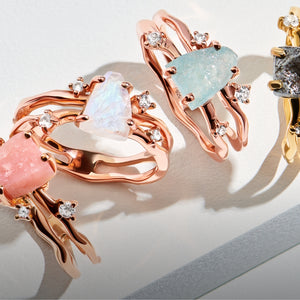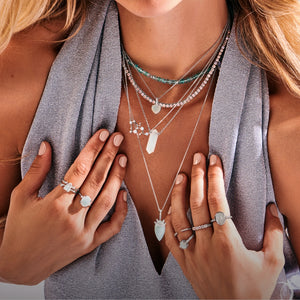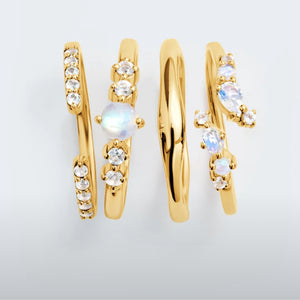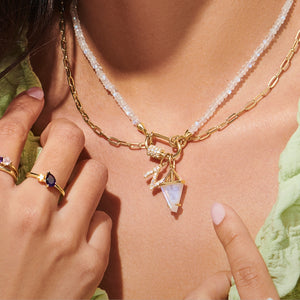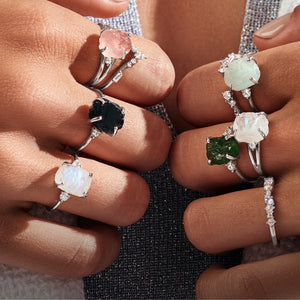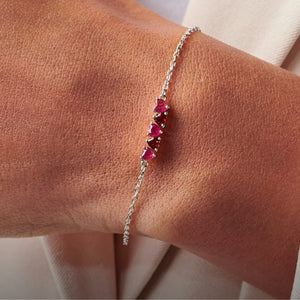March 19, 2023
🕐 6 Min Read
Heat Treated. Gemstone treatments have been used across cultures for centuries and are a common practice to bring out the best characteristics of a stone. Unpack the meaning behind heat treatment, learn the difference between enhanced and natural, and uncover the most commonly heat treated gemstones.
Everything You Need To Know About Heat Treatment
So you come across your favorite gemstone jewelry and two words catch your eye—heat treated. Questions come to mind: What does that mean? Does it affect the quality of my gem? Does this mean my gemstone isn’t natural?
In fact, most colored gemstones in the market have undergone heat treatment as a way to improve the stone’s color—and in cases like sapphire, clarity. Gemstone heat treatment is considered to be a stable, durable, and permanent treatment. In this post, we will answer all of your questions regarding heat treated gemstones.
What Is Heat Treatment?
Heat Treatment is a gemstone’s exposure to high temperatures that alters the color and increases the clarity. Specifically, heating is used to lighten, darken or enrich the color. Without heat treated gemstones, fine gems’ availability in the most desirable colors would be scarce. The price of the gemstone would also significantly increase.
Enhanced vs. Natural Gemstones
Heat is one of the forming conditions of a gemstone. This can occur within the ground or artificially. If the heat occurs while the gemstone is in the ground, it is not enhanced. However, if the gem undergoes heat treatment after being mined, it’s an enhancement.
Natural gemstones form within the earth. Stones such as Moonstone and Rose Quartz are typically not treated. However, some natural stones—like Amethyst, Topaz, Citrine, Sapphire, Ruby, Aquamarine, and Tanzanite—are usually heated after they’re recovered from the earth.
Why Is Heat Treatment Used?
Gemstone enhancements—such as heat treatment—improve the gems’ wearability and appearance. The treatment is chosen based on the gem type and desired effect.
What Is Radiation?
Although the term radiation seems terrifying, it’s simply another replication of a natural process. In a natural setting, benign radioactive elements impact many gemstones during formation.
Radiation in a facility modifies the electron sharing between crystal structures. This is usually followed by heating the gemstone to maintain the ideal color. Blue Topaz is one of the most well-known gemstones that's radiated. This is to bring out its brilliant blue hues in a deeper saturation.
Most Common Heat Treated Gemstones
Now that we’ve covered the ins-and-outs of heat treatment, let’s dive into the specific types of gemstones that undergo heat treatment and radiation.
Aquamarine
The Aquamarine is surprisingly one of the most common heat treated gemstones. Its natural form takes on more of a green tint. If the Aquamarine does not heat underground, enhanced treatment is the next best option. Heat in a controlled environment removes the greenish color and produces a prominent blue presence.
Green Onyx
The Green Onyx is dyed and heat treated to bring out its color intensity. This helps it turn the gemstone from a dull, unsaturated color to a vibrant, rich emerald-green.
Ruby
Heating the Ruby alters the color and improves the clarity. Many rubies from Thailand have a blue or purple core and tint. Specialists use heat to remove the blue and purple hues—thus forming a radiantly red stone with consistent color.
Additionally, heat treatment removes minute needle-like inclusions—known as silk—that causes the Ruby to be lighter in tone or more opaque. Under certain circumstances, heat treatment can also be used to recrystalize silk inclusions to make them more prominent. This is used to make the reflective star within star Rubies.
Rubies may undergo additional treatments to improve clarity or color.
Sapphire
The result of a heat treated Sapphire is an intensified blue hue. Similar to the Ruby, heating has potential to remove the silk inclusions and make the Sapphire more transparent.
It can also recrystalize to make the inclusions more prominent for a star-like effect. Interestingly, heated Sapphire is darker in color.
Like Rubies, Sapphires may undergo additional treatments to improve clarity or color.
Amethyst
To ensure that radiantly electric purple hue, heating removes the unwanted brownish tint in most natural Amethyst. Heat Treatment also lightens the color of the darker colored stones. Overall, the heated Amethyst is brighter and more vivid in color.
*This information discusses heat treated Amethyst in general. Moon Magic Amethysts attain their color naturally.
Citrine
Citrine is a yellow variety of quartz whereas amethyst is the purple variety. As citrine is less common, certain types of Amethysts may be heated extensively to turn their color from light purple amethyst to yellow Citrine.
*This information discusses heat treated Citrine in general. Moon Magic Citrines attain their color naturally.
At Moon Magic, we always strive to keep our gemstones as authentic and as natural as possible. We’ll always remain transparent about our gemstones’ appearance and sourcing.
View our collection of natural and enhanced gemstone jewelry.


















